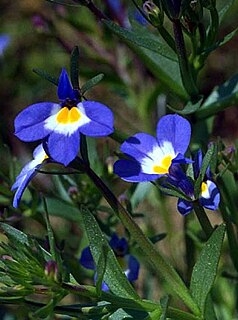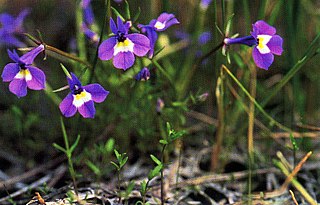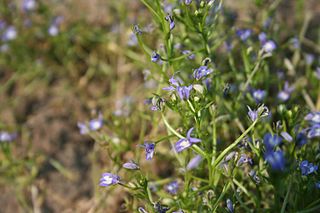
A raceme or racemoid is an unbranched, indeterminate type of inflorescence bearing pedicellate flowers along its axis. In botany, an axis means a shoot, in this case one bearing the flowers. In indeterminate inflorescence-like racemes, the oldest flowers are borne towards the base and new flowers are produced as the shoot grows, with no predetermined growth limit. A plant that flowers on a showy raceme may have this reflected in its scientific name, e.g. Cimicifuga racemosa. A compound raceme, also called a panicle, has a branching main axis. Examples of racemes occur on mustard and radish plants.

The family Campanulaceae, of the order Asterales, contains nearly 2400 species in 84 genera of herbaceous plants, shrubs, and rarely small trees, often with milky sap. Among them are several familiar garden plants belonging to the genera Campanula (bellflower), Lobelia, and Platycodon (balloonflower). Campanula rapunculus and Codonopsis lanceolata are eaten as vegetables. Lobelia inflata, L. siphilitica and L. tupa and others have been used as medicinal plants. Campanula rapunculoides may be a troublesome weed, particularly in gardens, while Legousia spp. may occur in arable fields.

A flower, sometimes known as a bloom or blossom, is the reproductive structure found in flowering plants. The biological function of a flower is to facilitate reproduction, usually by providing a mechanism for the union of sperm with eggs. Flowers may facilitate outcrossing resulting from cross-pollination or allow selfing when self-pollination occurs.

Downingia bella, also known as Hoover's calicoflower or Hoover's Downingia, is a member of the Bellflower Family (Campanulaceae). The genus is named after A.J. Downing (1815–1852) a noted American horticulturist and landscape architect.

Downingia is a genus of 13 annual plants native to western North America and Chile. Commonly known as calico flowers, they are notable for forming mass displays of small but colorful blooms around vernal pools. A number are uncommon endemics in California.

Downingia yina is a distinctive, colorful wildflower known by the common name Cascade calico-flower. It bears small, easily recognizable flowers up to 1 centimeter in width. Each flower has three fused lower petals which are blue or violet with a central spot which is white with a yellow center. This pattern is attractive to pollinating insects and helps them navigate to the flower's center. The two upper blue petals may fold together to face each other, or stick straight out.
This page provides a glossary of plant morphology. Botanists and other biologists who study plant morphology use a number of different terms to classify and identify plant organs and parts that can be observed using no more than a handheld magnifying lens. This page provides help in understanding the numerous other pages describing plants by their various taxa. The accompanying page—Plant morphology—provides an overview of the science of the external form of plants. There is also an alphabetical list: Glossary of botanical terms. In contrast, this page deals with botanical terms in a systematic manner, with some illustrations, and organized by plant anatomy and function in plant physiology.

Downingia bacigalupii is a species of flowering plant in the bellflower family (Campanulaceae) known by the common name Bach's calicoflower or Bacigalupi's downingia. This showy wildflower is native to the western United States from California to Idaho, where it is a resident of moist meadows and vernal pool ecosystems. This annual grows on a branching erect stem with small diamond-shaped leaves at intervals. At the top of each stem branch is one or more flowers, each between one and two centimeters wide. The flower has two long upper lobes which may be flat and straight or curl back, and are usually dark-veined blue. The three lower lobes are fused into one three-toothed surface, which is dark-veined blue with two bright yellow blotches rimmed with white in the center. The fruit is a dehiscent capsule two to five centimeters long. The stamens are fused together into an erect purple stalk bearing the dark anthers.

Downingia bicornuta is a species of flowering plant in the bellflower family known by the common name doublehorn calicoflower and double-horned downingia. This showy wildflower is native to the western United States from California to Idaho, where it is a resident of lakesides and vernal pool ecosystems.

Downingia concolor is a species of flowering plant in the bellflower family known by the common names maroonspot calicoflower and fringed downingia. This showy wildflower is endemic to California, where it is a resident of ponds and vernal pool ecosystems in the northern part of the state.
Downingia cuspidata is a species of flowering plant in the bellflower family known by the common name toothed calicoflower. This showy wildflower is native to California, where it is a resident of ponds, meadows, and vernal pool ecosystems throughout the state. Its range may extend into Mexico.

Downingia elegans is a species of flowering plants in the bellflower family known by the common names elegant calicoflower and Californian lobelia. This showy wildflower is native to western North America from California to British Columbia, where it is a resident of meadows and vernal pool ecosystems. This annual grows on a branching erect stem with many pointed leaves. At the top of each stem branch is one or more flowers, each one half to two centimeters wide. The tubular flower has two long, narrow, pointed upper lobes which are generally rich purple. The lower lip is fused into one three-lobed surface, which is purple with a large blotch of white in the center. The lobes may be quite pointed. There is sometimes some yellow coloration near the mouth of the tube.
Downingia insignis is a species of flowering plant in the bellflower family known by the common names harlequin calicoflower and cupped downingia. This showy wildflower is native to the western United States from California to Idaho, where it is a resident of lakesides and vernal pool ecosystems.
Downingia laeta is a species of flowering plant in the bellflower family known by the common name Great Basin calicoflower. This showy wildflower is native to western North America from California to Saskatchewan, where it is a resident of riverbanks, ponds, and vernal pool ecosystems. This annual grows on a thick erect stem with a few short, pointed leaves. Atop the stem is usually a single flower, which has an upper lip made up of two narrow, pointed lobes in shades of very light blue or purple, or white, and a lower lip which is a fusion of three lobes in the same color with two bright yellow spots and sometimes some purple or pink blotches or streaking.
Downingia montana is a species of flowering plant in the bellflower family known by the common name Sierra calicoflower. This showy wildflower is native to California, where it lives in the meadows and pine forests of the high mountains. Its range may extend into Oregon. This annual grows an erect stem, which may branch or not, with a few sparse small, pointed leaves. Atop the stem is usually one tubular flower. The upper lip is made up of two narrow, pointed lobes usually a shade of lavender, and the lower lip is the same color, with a central field of white and two prominent projections which may be colored yellow and dark purple. The lower lip has three lobes, each of which may have a tooth. The fruit is a capsule one to four centimeters long.
Downingia ornatissima is a species of flowering plant in the bellflower family known by the common name folded calicoflower. This showy wildflower is endemic to California, where it is a resident of vernal pools and other wet places in the Central Valley. This annual grows an erect, branching stem with usually one tubular flower at the top of each branch. The flower has an upper lip made up of two narrow, pointed lobes in shades of light purple, and a lower lip made up of three lobes fused into one surface, which is the same color as the upper lip and has a central field of white with two prominent yellow projections. The flower is similar to those of other downingias, except it is lightly crinkled, with the upper lobes often curled back and the edges of the lower lobes uneven. The dark blue anther just emerges from where it is tucked between the upper lobes.

Downingia pulchella is a species of flowering plant in the bellflower family known by the common names flatface calicoflower and valley calicoflower. This showy, annual wildflower is endemic to California, where it is a resident of vernal pools and other wet places in the central part of the state from the Tehachapi Mountains to the San Francisco Bay Area.

Grevillea shiressii is an Australian shrub of the family Proteaceae endemic to New South Wales, where it is found in only two localities near Gosford.

Porterella is a monotypic genus of flowering plants in the bellflower family containing the single species Porterella carnosula, which is known by the common name fleshy porterella, or simply porterella.
The floral axis is the area of the flower upon which the reproductive organs and other ancillary organs are attached. It is also the point at the center of a floral diagram. Many flowers in division Angiosperma appear on floral axes. The floral axis can differ in form depending on the type of plant. For example, monocotyledons have a weakly developed floral axis compared to dicotyledons, and will therefore rarely possess a floral disc, which is common among dicotyledons.











